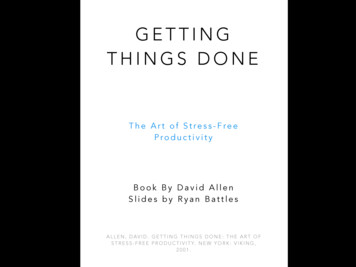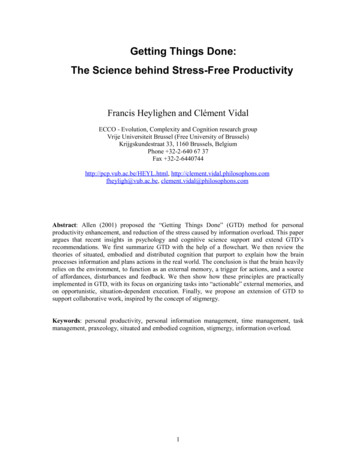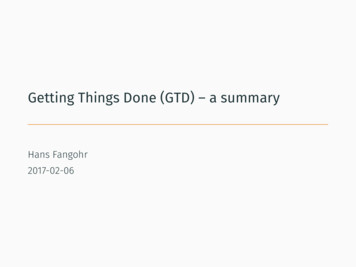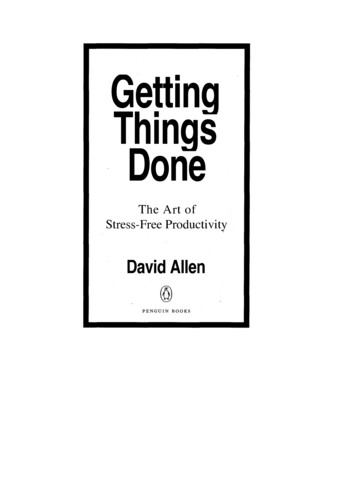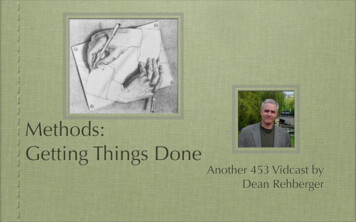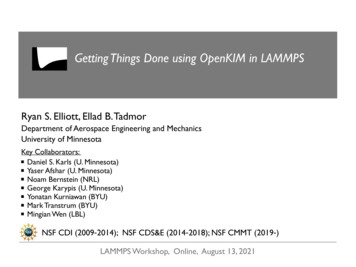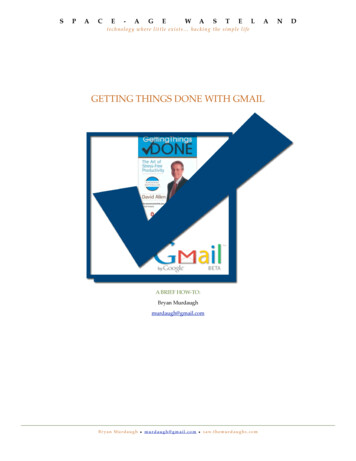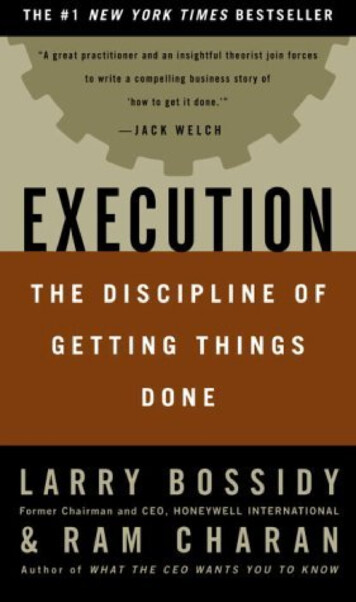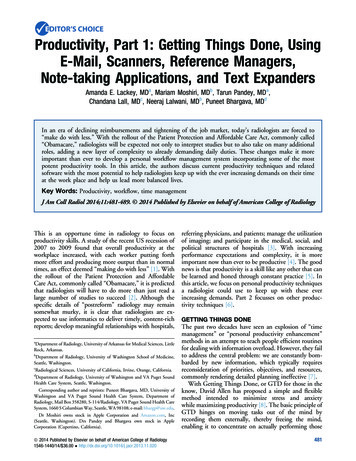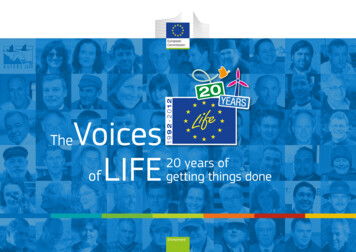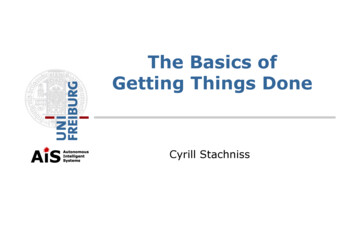
Transcription
The Basics ofGetting Things DoneCyrill Stachniss
Getting Things Done or the art of stress-free one-Stress-Free-Productivity/dp/0142000280
Motivation for GTD The boundaries of today’s work are notclearly defined anymore Traditional to-do list do not reallycorrespond to the way people worktoday There are many more inputs today(email, text msgs, mobile phones, ) The volume of input is higher and itarrives faster than 20 years ago
Problems of Knowledge Workers ProcrastinationAvoiding things you should doThere are items that always stay on your todo listAlthough you think you plan things well, theysometimes get out of controlAlthough you worked a lot, you have thefeeling of having nothing really accomplishedYou feel that there is too much stuff to doThings pop up to your mind in situations whenyou cannot do anything about themYou do not have a clear mind
GTD AimsProviding strategies for how to be more relaxed and less stressed accomplish more be more creative keep track of relevant thingsby supporting to define your work and priorities help to organize and structure yourwork
Creativity Needs a Clear MindImage courtesy by Ming Gong; by Ming Gong, 2009, minggongphotography.com
Why are Things on Your Mind? You have not clarified the indentedoutcome You have not decided what the physicalnext action towards the outcome is You have not put reminders of theoutcome and action in a system thatyou truly trust
Transforming “Stuff” A lot in GTD is about the transformationof “stuff” to clear your mind “Stuff” is everything in your physicalor psychological world that it is notwhere it belongs to or for which youhave not defined a desired output
The Need of a Trusted System Our mind often reminds us about thingson which we cannot do anything at themoment As soon as your brain knows that yourideas, goals, and actions are stored in asafe place, it will stop reminding you So capture everything an store it in atrusted system GTD is about transforming stuff but alsoabout managing your trusted system
The Ideas of GTD on One Slide Identify all the stuff in your life that is not inthe right placeGet rid of the stuff that is not yours or you donot need right nowCreate a right place that you trust and thatsupports your working style and valuesPut your stuff in the right place, consistentlyDo your stuff in a way that honors your time,your energy, and the context of thegiven momentIterate and re-factor mercilessly
Five Key Steps of the (Daily)GTD Process Capture/CollectProcessOrganizeReviewDo
Step 1 – Capture/Collect Capture every idea, to-do item, orthought that is worth to remember Capturing it means to safely store thatinformation in an inbox/in-basket Have safely stored the thought is thefirst step towards doing an action The thought is off your mind – yourmind does not need to remind youanymore Empty the inbox regularly
Step 1 – Capture/Collect
Step 2 – Process Processing means to look at thecaptured things and to decide what todo with it Steps of processing stuff Remove it from the inboxIdentify what it isIdentify if it is actionableIdentify the direct next actionDecide what to do with that next action
Step 2 – Process
The Need of Contexts Most actions have a context – only inthis context you can do the action E.g., no need to remind you at workthat you have to fix a lap at home Grouping actions by context also allowsyou to reduce context switches whileperforming actions
Step 3 – Organize Organize the items and actionsProject planningWaiting-for materialTime planning/calendarUpdate project support materialNot actionable items Trash Archive/reference material Someday/maybe items
Step 3 – Organize
Step 3 – Organize
The Archive A system to store non-actionable itemsEasy to add and retrieve materialA good archive is essential for GTDYou need to trust your archiveOften, you will need two systemsDigital Papers/TutorialsSlidesProject materialEmails Paper-based Official documentsLetters/billsTax
The Paper-based Archive Typically a traditional folder system Own folders for larger projects/topics(e.g., tax, credit card bills, ) A-Z filing systems for everything else
The Digital Archive Modern computer systems have quite goodsearch engines (e.g. spotlight)Many systems support tags for efficientclassificationsI tend to separate email from the rest(I simply receive too many emails)Example:Yep2
The Someday/Maybe List Things you want to do but not now “Parking lot” for ideas that should notbe lost but do not fit in your currentplans Examples Travels to make Learn Spanish Books I might want This list is not a second trash bin Needs to be reviewed frequently
Step 3 – Organize
The Waiting-for List Whenever you delegate a task, makesure you track it Do forget things because your reminderis the reply or input of someone else A waiting-for list is a very powerful toolthat helps to keep things under control Define deadline when to re-contact aperson if you received no reply
The Calendar Calendars are common and powerfultools to organize dates ad deadlines The calendar should only host time- orday-specific events or information Treat you calendar as a holy territory –only add what is really relevant Do not plan what actions you intend todo in your calendar – distractions willmess up the schedule anyway in reality
The Next Actions Lists The lists that host all your next actions Formulate them as actions(“Call Fred (#) about Lunch on 1.1.11”instead of “Fred, Lunch”) Typically grouped by projects and/orcontext Easy to maintain in a digital system(different view on a database) Requires somewhat more organizationalefforts if implemented paper-based
Step 3 – Organize
How to Plan a Project In GTD, a project is something thatneeds more than one action Small projects are defined straightforward, but planning larger projectscan be a challenge How to plan a larger project?
The Natural Planning Model A sequential, five-step process1.2.3.4.5.Define purpose and principlesOutcome visioningBrainstormingOrganizingIdentifying the next actions Perform these steps sequentially, thistypically improves the project plan
1. Define Purposeand Principles WHY? First, sketch the purpose. That is ofteneasy but triggers the following steps It defines success, decision-makingcriteria, and clarifies the focus Principles are the boundaries of the plan Complete: “I would give other total freerein to do this as long as they ” It helps you to define your “standards”
2. Vision and OutcomeWHAT?What do you imagine about the project?Sketch the picture you have in mindImagine the status of the project frombeyond the completion date Envision “wild success”
3. Brainstorming HOW? Capture the ideas on how to realizewhat you imagined before in step 2 Brainstorming keys Do not judge, evaluate, or criticize Go for quantity not quality Put analysis and organizational aspects tothe background Write things done on a piece of paper Mind maps are helpful for some people
4. Organizing Once you “emptied your head” in step 3it is time to organize, judge, andevaluate your ideas Identify components, subcomponents,deadlines, milestones, dependencies Recursively refine the individual pieces Tools: Gantt charts, Pert diagrams Most people that talk about projectplanning refer to this step (and oftendo ignore the others)
5. Next Actions After identifying the components in step 4,define the next physical actions that needto be takenAdd them to your listsQuestion: Is all that really needed? It depends on the person and its experience and thesimilarity to previously realized projectsRecommendation: Do it for some time withthis granularity and try it out!
Step 4 – Review Reviewing your projects, actions, listson a regular basis is essential The goal of the review is to ensure thatall projects/actions are up to date Update your lists Remove irrelevant/expired actions Review all your Waiting-for lists Are all actions in line with your goals Are there any uncollected items? Recommendation: a weekly review
Step 5 – Do Do the actions you specified before Models for choosing actions Four-criteria model for choosing actions at agiven moment Threefold model for evaluating daily work The six-level model for reviewing your ownwork These models do not tell you what todo but should support you to frameyour options in a smarter way
Four-Criteria Model forChoosing Actions at Moment Apply the four simple criteria forchoosing actions to do ContextTime availableEnergy availablePriority
Threefold Model forEvaluating Daily Work When working, one can do threedifferent kinds of activities Doing predefined work(the actions defined in steps 1-4) Doing work as it shows up(ad-hoc events or surprises mayrequire immediate actions) Defining your work(doing GTD)
The Six-Level Model forReviewing Your Own Work Goal: Support to define your priorities This models uses 6 levels/perspective 50,000 ft: Life40,000 ft: Three- to five-year vision30,000 ft: One- to two-year goals20,000 ft: Areas of responsibility10,000 ft: Current projectsRunway: Current actions Defining your 6 levels helps to intuitivelycome up with priorities for your actions
GTD Overview& regularreviews
Tools to Implement GTD I found it important to have good toolsto implement GTD The GTD book is from 2002 and a lothas happened in terms of GTD software There are many people implementing itwith a paper-based notebook probably not the preferred solutionfor geeks
Important Features (for Me) Easy & quick to capture/collect stuff Import of & references to emails,copied text, and any files Allows to define context, start and duedates Predefined context-view Easy to re-organize actions and project Possibility to sync with my phone Sync between different computers
My Favorite Tool: OmniFocus OmniFocus from The us/Also has its disadvantages: OSX/iPhone only, no web interface,not free (50 -80 )
OmniFocus ScreenshotProjectsActionsContext DeadlineAction GroupsOverdueDue soon
Find Your Own Tools/Setup Everyone has different needs Start with a simple text editor,that works surprisingly well After some time, evaluate differenttools to see if this improves yourproductivity and comfort
What are Typical AchievementsWhen Applying GTD Less things that block yourself frombeing creative and productive Less procrastination Less things get lost More things get done in time Less stress More precisely planned projects Ability to quickly find archiveddocuments
Why GTD may not WorkYou track only a part of your “stuff”You do not trust your systemYou are not doing a regular reviewYou are not familiar with the softwaretools you use You “over-engineer” your system(too many folders, special cases, etc) Your system is too complex or too easy(“keep it as simple as possible and ascomplex as needed”)
A few Remarks When Starting Setting everything up may take a fewdays – but its worth investing that timeYou need silence to initially write downeverything which is on your mindIt takes a while until your mind startstrusting your systemKeep your archive easily accessibleSelect a predefined date for a weeklyreview (e.g., Fridays at noon)Read the GTD book
More About GTD Read David Allen’s GTD book“GTD for Geeks” on 43foldersInbox Zero of Merlin MannGood podcasts of David Allen and MerlinMannSome links /
GTD in Small Teams GTD itself is a one-man show, nomeans for team work In most settings, however, GTD can beapplied very well if Everyone applies GTD personally You can rely on that if you send a task tosomeone, it is captured, processed, etc.appropriately Everyone knows that you track the taskassignments (e.g., waiting-for list)
GTD in Small Teams Nothing is allowed to be “lost”everyonedoes GTD Creating minimal overheads Observation: there will be moreprogress on the “important” projects How to make a project important? Important projects have One responsible personA clearly defined goalA deadline(A budget) - probably does not apply here
Inbox Zero A GTD-like system toprocess your emailsby Merlin Mann Relevant if you think that you spend toomuch time with your email Key ideas have been presented in aGoogle Tech Talk, seehttp://inboxzero.com/
Inbox Zero Essentials Never check your emails, processyour emails Process your inbox to zero Convert relevant emails into actions Do not use your inbox as a to-do list(no one would allow anyone to adduseless stuff to the own to-do list) Open an email in your inbox only onceand decide directly what to do about it
Process Your Emails
Process Your Emails
Process Your Emails
Keeping Emails in Your Inbox requires you to repeatedly re-analyzewhat to do with an email promotes procrastination requires to keep the email client openall time which causes distractions
Reduce Distractions Creative and productive requiresdistraction-free blocks of time Email clients frequently check emailsand will bother you with notificationsInbox Zero Strategy: Process your email to zero Close your email client for at least60 minutes (or longer) Work (do things!)
Summary This talk was intended tosketch GTD To implement it, read the book Good tools are important toreally implement GTD Spent too much time on email:Watch the inbox-zero (Google)
The Ideas of GTD on One Slide Identify all the stuff in your life that is not in the right place Get rid of the stuff that is not yours or you do not need right now Create a right place that you trust and that supports your working style and values Put your stuff in the right place, consistently Do your stuff in a way that honors your time,File Size: 2MBPage Count: 60People also search forexamples of unsafe work environmentsgetting things done pdf chartgetting things done flow chartget things done templatethe tracking journalgetting things done summary pdf

